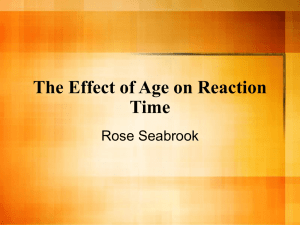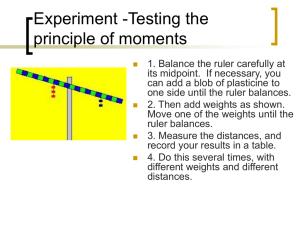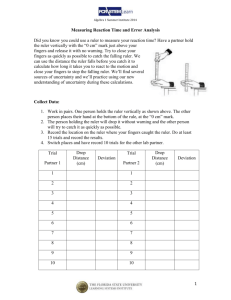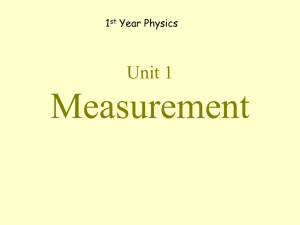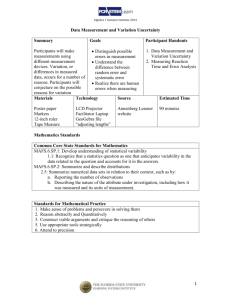7_3_Density_of_Ruler..
advertisement
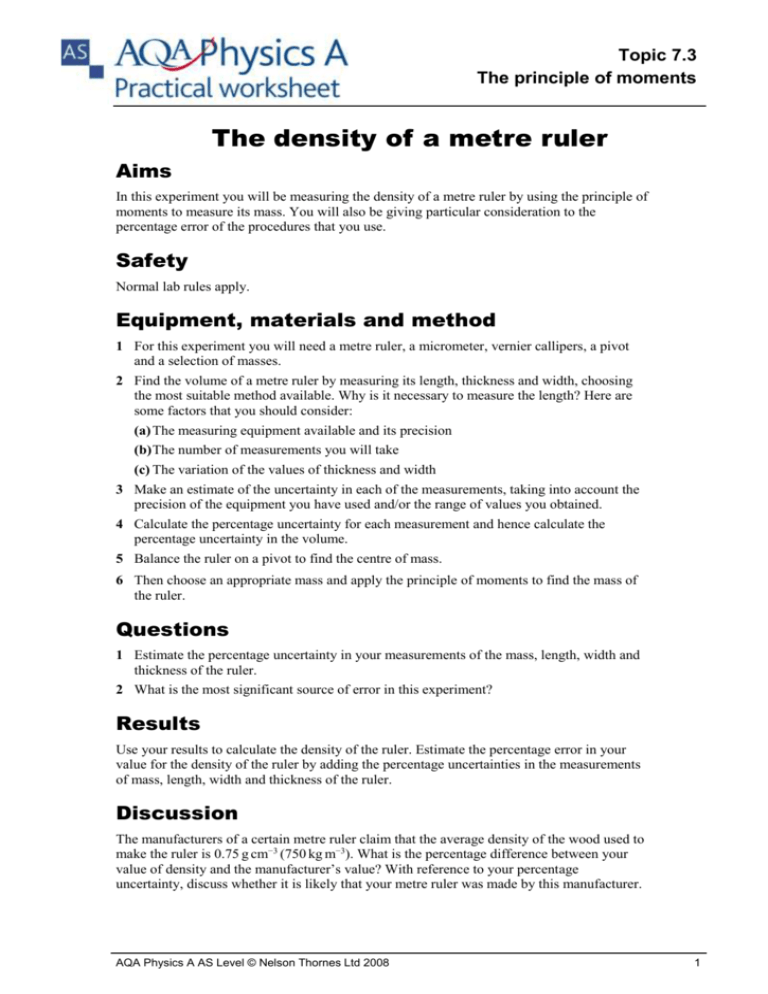
Topic 7.3 The principle of moments The density of a metre ruler Aims In this experiment you will be measuring the density of a metre ruler by using the principle of moments to measure its mass. You will also be giving particular consideration to the percentage error of the procedures that you use. Safety Normal lab rules apply. Equipment, materials and method 1 For this experiment you will need a metre ruler, a micrometer, vernier callipers, a pivot and a selection of masses. 2 Find the volume of a metre ruler by measuring its length, thickness and width, choosing the most suitable method available. Why is it necessary to measure the length? Here are some factors that you should consider: (a) The measuring equipment available and its precision (b) The number of measurements you will take (c) The variation of the values of thickness and width 3 Make an estimate of the uncertainty in each of the measurements, taking into account the precision of the equipment you have used and/or the range of values you obtained. 4 Calculate the percentage uncertainty for each measurement and hence calculate the percentage uncertainty in the volume. 5 Balance the ruler on a pivot to find the centre of mass. 6 Then choose an appropriate mass and apply the principle of moments to find the mass of the ruler. Questions 1 Estimate the percentage uncertainty in your measurements of the mass, length, width and thickness of the ruler. 2 What is the most significant source of error in this experiment? Results Use your results to calculate the density of the ruler. Estimate the percentage error in your value for the density of the ruler by adding the percentage uncertainties in the measurements of mass, length, width and thickness of the ruler. Discussion The manufacturers of a certain metre ruler claim that the average density of the wood used to make the ruler is 0.75 g cm−3 (750 kg m−3). What is the percentage difference between your value of density and the manufacturer’s value? With reference to your percentage uncertainty, discuss whether it is likely that your metre ruler was made by this manufacturer. AQA Physics A AS Level © Nelson Thornes Ltd 2008 1 Topic 7.3 The principle of moments Teaching Notes Aims To use simple measurements of length and distance, and the application of the principle of moments to determine the density of a meter ruler. To consider the significance of the error of the measurements. To use knowledge of uncertainty and errors to make an informed decision about the manufacture of a meter ruler. CLEAPSS information on care and adjustment of micrometers: Laboratory Handbook/CD-ROM section 10.4.1. Safety There are no significant safety issues. Teaching notes 3 If measuring equipment is limited, this experiment could be carried out in two groups. One group performs the measurement of the volume while the other group completes the measurement of the mass. Then the groups either exchange and discuss methods and results, or simply swap equipment. 4 Approximately 10 minutes should be allocated to each section of this experiment (10 minutes for the measurement of volume and 10 minutes for the measurement of mass). Considerably more time will be necessary for the discussion of results and uncertainties, depending on teaching approach and student knowledge. 5 Measurements of width and thickness should be repeated and measured at different places on the ruler. 6 Micrometers or vernier callipers can be used, ideally both should be provided. 7 It is recommended that students carry out calculations in SI units in order to avoid confusion. 8 Ensure that when balancing the mass on the ruler, the mass is a sufficient distance from the pivot in order to obtain a reasonable measurement. For this reason the 100 g mass is the most appropriate selection. Note that the distance d1 is measured from the centre of the mass. 9 This experiment could be enhanced by providing different groups with different equipment and asking each group to report back to the class. AQA Physics A AS Level © Nelson Thornes Ltd 2008 2 Topic 7.3 The principle of moments Answers to questions The most significant source of error is probably variations in the dimensions of the ruler itself. This can be minimised by repeating readings at different places, or by taking readings from a number of different rulers and averaging. Discussion 1 The precision of a micrometer is ± 0.01 mm and the precision of vernier callipers is ± 0.1 mm (± 0.02 and ± 0.2 respectively are also acceptable). Note that the total uncertainty of a measurement takes into account an uncertainty at either end of the length to be measured. The minimum uncertainty at either end is equal to half a division of the scale. 2 The uncertainty in the length of a meter ruler is ± 1 mm. 3 The length of the ruler should be measured in case the ends have been worn or chipped through use. 4 The total uncertainty in the volume is calculated by adding the percentage uncertainties in each of the three measurements: thickness, width and length. 5 To find the total uncertainty in the density, add the percentage uncertainty in the volume to the percentage uncertainty in the mass (10% as given). 6 Find the percentage difference between the measured value of density and the manufacturer’s value. Compare this percentage with the total percentage uncertainty of the measured value of density. Practical assessment opportunities 7 PSA – Selecting and using equipment: 0–3 marks (Following instructions and group work; organisation and safety assessed at end of course.) 8 ISA preparation: practical task – practice in recording measurements and estimating errors written task Section A and B – opportunities to discuss precision, analyse data and errors AQA Physics A AS Level © Nelson Thornes Ltd 2008 3 Topic 7.3 The principle of moments The density of a metre ruler Equipment and materials required Each group or pair of students will require the following equipment: a metre ruler a micrometer a set of vernier callipers a pivot (This could be a simple knife edge pivot, for example, a prism or a thin steel rod held in a clamp.) 10 g, 50 g, 100 g and 200 g masses CLEAPSS information on care and adjustment of micrometers: Laboratory Handbook/CD-ROM section 10.4.1. Safety Normal lab rules apply. AQA Physics A AS Level © Nelson Thornes Ltd 2008 4

